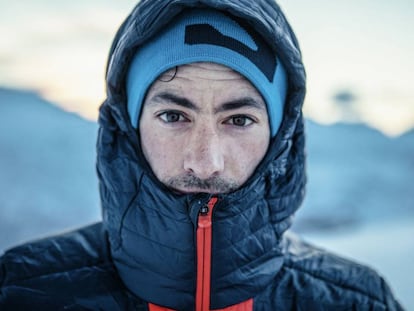‘Touching the Void’: Would you cut the rope to survive?
The book by British climber Joe Simpson about his efforts to save Simon Yates on their 1985 descent of Siula Grande raises important questions for the reader
No piece of fiction can compete with the real-life drama of the mountain adventure shared by Joe Simpson in his book Touching the Void. This is not a book review. With or without spoilers (there are some), the reason why his story deserves to be read is that, by the end of it, the reader will inexorably be faced with many questions – the answers to which they will not be able to hide from.
In 1985, two young British climbers who knew each other by sight decided to climb the Peruvian Andes. Joe Simpson, the elder climber, was 25 years old, and his partner Simon Yates was just 22. With more courage than hands-on experience, the two made a first ascent of the West Face of Siula Grande mountain (6,334 meters) via an extremely technical route. When they reached the summit, the bad weather that had held them so much during the ascent, closed in on them severely, turning their descent down the northernmost arête into more of a high-stakes getaway than a simple return to civilization.
In their rush, Simpson slipped, fell and broke a tibia: staying alive no longer depended on him, but rather the empathy of Yates. They were not friends, just climbing partners by chance; the relationship was only made to quench their thirst for adventure. Yates could have left Simpson up there; he could have promised to return with help and flee to save his life. But he didn’t do that. Simpson would have died and Yates would have survived. At that moment, they were condemned to perish together or wait for a miracle to be saved. Pragmatic and a touch phlegmatic, Yates offered to help. This moment would lead to a series of events that would change his life. Simpson would never forget looking at Yates and seeing in his eyes his resolve to help him.
In the world of mountaineering, the relationship between climbing partners is sacred. Its value is a recurring theme in classic literature that extols the magic of solidarity, teamwork, camaraderie and commitment that is formed naturally when two people are connected by a rope. How can one not admire the partnerships formed by climbing legends Lionel Terray and Louis Lachenal, Chris Bonington and Doug Scott, and Reinhold Messner and Peter Habeler? The partnership is a defense of ethical values, of a certain courage in the face of possible success and the shadow of disgrace. If Yates did not abandon Simpson it was because he could not have lived with himself, being so young and with all of his future ahead of him.
With zero visibility and Simpson unable to walk, Yates decided to ease his partner down with the support of two 50-meter ropes they were carrying. He tied them to one another to have 100 meters in length, and then tied one end of the rope to himself and the other to Simpson’s harness. Standing firm in the snow, Yates lowered Simpson down over the frozen edge, using a braking system that allowed him to control the speed of his descent.
There was only one problem: once Simpson had been lowered 50 meters, he had to stand up on his good leg so that the rope. This gave Yates enough slack so that he could move the knot between the two ropes to the other side of the brake system and lower him another 50 meters. This had to be done every 100 meters. Simpson stood firm in the snow and waited for Yates to descend before repeating the process. The system was as slow as it was effective. It worked and they were close to salvation. They were completely dependent on their tenacity: there was no way to get outside help.
Towards the abyss
But everything became terribly complicated. The snow stopped Simpson from seeing a cornice in the mountainside, a hidden crevasse: he plummeted 30 meters. Yates stopped his fall but Simpson was hanging in the air, and the weight of his partner was pulling on him. How long would he be able to hold on? The snow prevented Simpson from seeing the magnitude of the abyss below his feet. How many meters would he fall before dying on impact? How long would it take to die? Unable to climb up the rope, Simpson thought of saving Yates by cutting the rope that tied them together in such an awful way. But the only knife they had was in Yates’s backpack.
The weight of Simpson became unbearable: Yates was fighting with everything he had to dig his crampons in the snow and stop himself flying off into the abyss. He did everything he knew and was able to do to save both lives but after an hour of suffering, he understood that his life depended on a simple but terrible action: cutting the rope. It was getting dark when the blade of the knife cut through the rope and Simpson fell directly on a bridge of snow until nearly the bottom of the crevasse. Miraculously he survived and was unhurt except for a broken leg. The next morning, with visibility, Yates found the crevasse and assumed that Simpson had fallen to the bottom and was dead.
But three days later, when Yates was about to leave base camp, a ghost appeared, hauling himself over the rocks: it was Simpson. He had been able to crawl out of the crevasse, orientate himself and survive without food and by drinking melted ice.
Both continued to climb mountains, but they never climbed together again. What had brought them so close also repelled them. Yates was the target of severe criticism, he suffered a tremendous popular trial. Even though Simpson defended him, he was forever seen as the man who cut the rope. It didn’t matter that Simpson said he would have done the same. Almost everyone forgets that in order to play the role of the villain, Yates first had to be a hero. And in this way, the book presents the reader with two questions: would they have risked their life and stayed with Simpson? And would they have cut the rope to survive?
Tu suscripción se está usando en otro dispositivo
¿Quieres añadir otro usuario a tu suscripción?
Si continúas leyendo en este dispositivo, no se podrá leer en el otro.
FlechaTu suscripción se está usando en otro dispositivo y solo puedes acceder a EL PAÍS desde un dispositivo a la vez.
Si quieres compartir tu cuenta, cambia tu suscripción a la modalidad Premium, así podrás añadir otro usuario. Cada uno accederá con su propia cuenta de email, lo que os permitirá personalizar vuestra experiencia en EL PAÍS.
¿Tienes una suscripción de empresa? Accede aquí para contratar más cuentas.
En el caso de no saber quién está usando tu cuenta, te recomendamos cambiar tu contraseña aquí.
Si decides continuar compartiendo tu cuenta, este mensaje se mostrará en tu dispositivo y en el de la otra persona que está usando tu cuenta de forma indefinida, afectando a tu experiencia de lectura. Puedes consultar aquí los términos y condiciones de la suscripción digital.











































